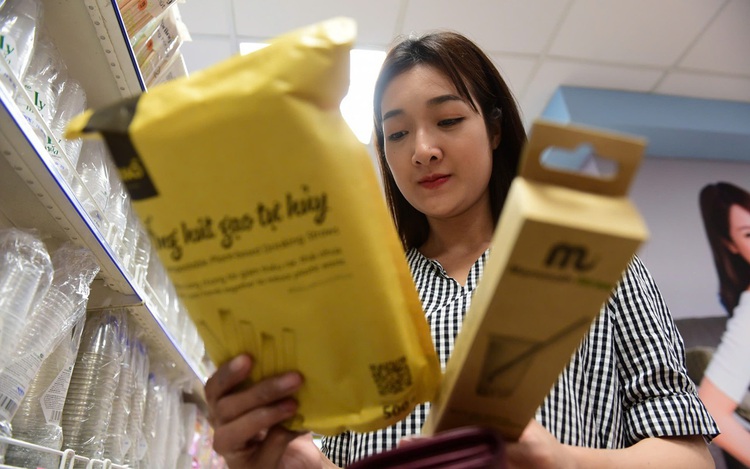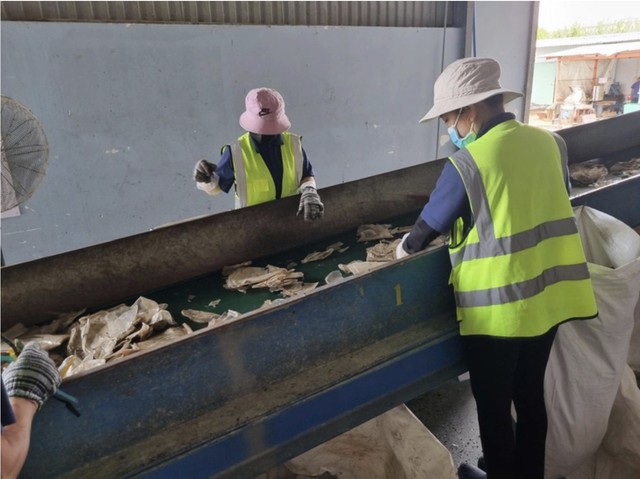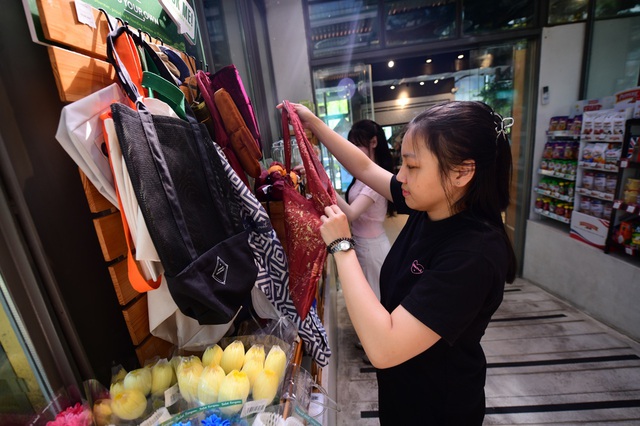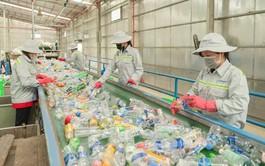
Eco-friendly products are gradually taking over shelves in Vietnam. Photo: Quang Dinh / Tuoi Tre
From SABECO beer cans made thinner to Nestlé’s La Vie water bottles produced from recycled plastic, sustainable packaging is reshaping Vietnam’s consumer goods sector.
Behind these shifts lie both opportunities and challenges for the domestic recycling industry, a field with great potential but still in need of stronger momentum to achieve a real breakthrough.
Recycled materials take the lead
In Vietnam, Saigon Beer-Alcohol-Beverage Corporation (SABECO) has steadily improved its packaging, such as reducing the thickness of aluminum coils for can lids from 0.245 mm to 0.240 mm.
This has cut the weight of cans and lids by 15 percent compared with 2019.
The company aims for 100 percent of its packaging to be reusable or recyclable by 2040.
From a business perspective, this approach helps build a sustainable competitive advantage as consumers and investors increasingly prioritize environmentally responsible brands.
“Green packaging also helps us strengthen customer trust, especially among young people,” a SABECO representative said.
Lester Tan, general director of SABECO, affirmed that sustainable development is the 'guiding principle' shaping the company’s identity and corporate strategy.
“By managing resources responsibly, improving operational efficiency, and focusing on employee and community development, we believe we can continue to build a sustainable growth model that generates long-term positive impacts on both the environment and society,” he emphasized.

A section of the assembly line sorting scrap materials at the Dong-A plastic recycling plant. Photo: PRO Vietnam
Meanwhile, Nestlé -- another major player in the food and beverage industry -- reported that 94 percent of its packaging is now designed to be recyclable.
Popular products such as Milo, Nescafé, Maggi soy sauce, and KitKat bars have all adopted more eco-friendly materials.
“The Maggi bottle no longer uses plastic shrink wrap, coffee capsules have a reduced wrapping layer, and La Vie has launched water bottles made of recycled plastic,” a Nestlé representative explained.
The shift toward sustainable, circular packaging not only benefits the environment but also creates strategic opportunities for businesses.
For companies, investing in green packaging is more than a cost-saving or resource-conserving measure, it is a lever to gain a competitive advantage as consumer expectations continue to rise.
Barriers to overcome
Despite strong determination, businesses still face hurdles on the path to greener operations.
A SABECO representative acknowledged that optimizing packaging design to meet recycling standards while preserving product quality and consumer experience is a complex challenge.
Everything, from material selection to weight calculation and compatibility with existing recycling infrastructure, requires major investment in technology and resources.
From the recycler’s perspective, Le Anh, director of sustainability development at Duy Tan Recycling, said recycled plastic currently costs about 30 percent more than virgin plastic.
The main reason is ineffective waste separation at the source, which raises treatment costs and reduces raw material quality.
As a result, businesses seeking to integrate recycled materials into production lines often struggle to balance costs.
A representative of Dong-A Industrial Co., Ltd. added, “Vietnam still lacks material recovery facilities that meet modern technological standards and capacity requirements.
"Sorting stations allow recyclers like us to access higher-quality scrap sources, which helps cut costs and reduce the resources needed for input processing.”
Still, the domestic recycling industry has shown positive signals since the Extended Producer Responsibility (EPR) policy came into effect.
According to Dong-A, after the policy was enforced, many recycling facilities shifted from relying on imported materials to using domestically collected sources.

By practicing effective waste separation at the source, consumers help improve the productivity and efficiency of the entire collection and recycling system. Photo: Quang Dinh / Tuoi Tre
At the same time, the collection process has gradually become more transparent to comply with legal regulations and industry standards.
"The government should adopt policies to promote the use of recycled materials, such as mandating a minimum percentage of recycled content in packaging, to ensure stable demand for recycled products," A Dong-A representative suggested.
A representative from the Packaging Recycling Organization Vietnam (PRO Vietnam) stressed that for the recycling market to truly break through, comprehensive solutions are needed.
The most important of these is promoting waste separation at the source, which improves the quality of recyclable materials and reduces costs for sorting and processing in later stages.
In parallel, communication and education campaigns on the environmental importance of recycling should be strengthened.
The government is also encouraged to support the research and development of new recycling technologies, which will add value and increase recovery rates.
EPR policy: The key to change
The EPR policy is seen as a turning point for Vietnam’s recycling industry.
Instead of relying on imported inputs as in the past, recycling facilities are now drawing more from domestic collection.
The process has also become more transparent, compliant with regulations, and aligned with industry requirements.
This is viewed as the foundation for the recycling sector’s sustainable development in the years ahead.



Max: 1500 characters
There are no comments yet. Be the first to comment.